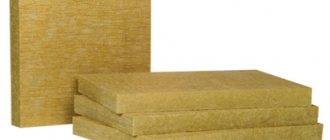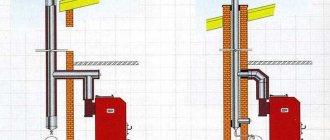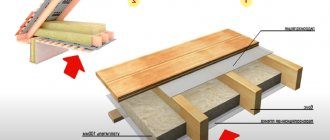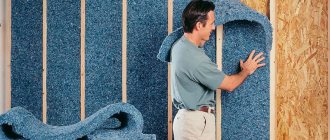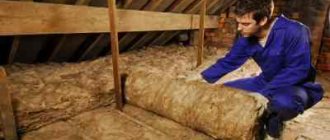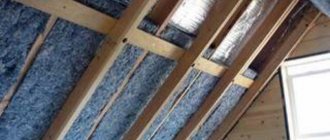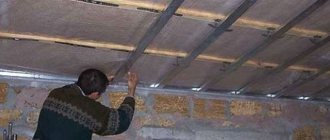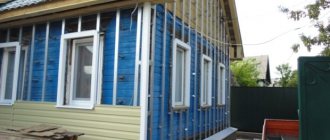An analysis of heat loss in a residential building shows that the floor, walls, windows and roof are approximately equally involved in heat loss. That’s why they install expensive double-glazed windows and insulate them from the bottom, sides and top. And for some reason little attention is paid to the ceiling. But through it, more precisely, through each m2 of ceiling space, heat is lost several times more than through a similar area of walls and roof.
From the above, it logically follows that by insulating a small ceiling, the owners prevent significant (up to 25%) heat losses and significantly save on insulation and the cost of thermal insulation work. The only thing that needs to be taken into account is the presence of an attic. If you plan to use the attic space for living space, then insulating the ceiling loses its meaning.
The editors of the StroyGuru website decided to draw the attention of their visitors to the problems of ceiling insulation and prepared a series of articles on this topic. They will examine in detail insulation technologies using the most popular types of thermal insulation materials, as well as new products. In this work, we will consider in as much detail as possible which insulation can be used for the ceiling in a cold attic.
Choice of insulation
Before purchasing thermal insulation material, it is necessary to take into account several quality characteristics, including:
- degree of vapor permeability;
- weight;
- strength;
- flammability;
- price.
There are two types of ceilings:
- Made from concrete slabs
. These products do not burn and have high load-bearing capacity. Concrete is considered to have partial vapor permeability. But for slabs this indicator is insignificant and therefore, when choosing which insulation is best for the ceiling, it is customary not to take it into account. - Wooden
. In private households, ceiling structures are often made of wood, which burns well and allows a little steam to pass through. If you block the air supply to the rafters, they will begin to rot over time. In addition, laying flammable insulation on a wooden surface is very dangerous.
One of the main parameters that influences which insulation to choose for the ceiling is where it is installed. This is explained by the fact that the ceiling can be thermally insulated both from the side of the unheated attic space and from the inside of the building.
For the home craftsman, the easiest way to do insulation is in the attic, because in this case there is no need to hem the ceiling from below. In addition, in the case of external installation, you will not have to decide what thickness of insulation is best to use, since there will be enough space in the attic. You can use both bulk material and in the form of slabs. You need to choose insulation for the attic based on your specific situation.
The situation is different with the installation of thermal insulation from inside the room. In private homes, you can’t always find really high ceilings, which means you will need to take every centimeter away from the living space.
As practice shows, property owners rarely decide to lower the ceiling surface by more than 15 centimeters. Accordingly, it is better to use insulation that is lightweight, but at the same time durable and with a low degree of thermal conductivity.
To find out which insulation is better for the ceiling under certain operating conditions, you should analyze information about the materials most often used in construction.
Insulation works
Ceilings separating rooms of different types require additional heat, steam or waterproofing. In a multi-storey building, overlap between residential tiers is rarely required.
The exception is hollow blocks with open voids. The type of roof of a building determines the optimal insulation method. Ceiling insulation from the inside is suitable both for the upper floors of buildings with a flat roof, and for rooms not adjacent to it, but requiring additional thermal insulation.
A gable roof is primarily insulated from the inside, but the ceiling between the cold attic and the living floors also needs a thermal insulation layer. The main stages of insulation work are similar, regardless of the type of material chosen.
The waterproofing is attached with a reflector inside the room and glued with tape
Thermal insulation using foam plastic
In terms of popularity, this material occupies a leading position because it is lightweight, accessible and inexpensive. The strength of the foam will be sufficient for arranging insulation. Laying this material does not require special knowledge or high professionalism. But polystyrene foam also has disadvantages - low vapor permeability, and besides this, it burns well.
Is it possible to sew wooden floors with this material from the outside or inside? There is no clear answer to this question. It is undesirable to lay polystyrene foam in a continuous layer on top, because then warm and humid air will begin to accumulate in the wood, resulting in the appearance of fungus and mold.
If you install this insulation on wood from the inside, then air access will be provided from above to the ceiling, but there is no point in clogging the ceilings with waterproofing in a breathable and environmentally friendly house.
In some cases, some craftsmen lay foam plastic between the load-bearing ceiling beams, while others have a negative attitude towards this approach. The fact is that the beam has a minimum thickness of 15 centimeters and, if it is clamped on both sides with this material, it will not cope with the effects of moisture and will become damp.
Taking into account the above information, we can conclude that polystyrene foam is a good choice when you need to decide what kind of insulation to insulate the ceiling both outside and inside, if it is made of reinforced concrete slabs. When the floor is made of wood, the use of this material is undesirable.
Nowadays extruded polystyrene foam, a modern type of foam, is no less popular. It does not allow moisture to pass through and retains heat 30% better. Expanded polystyrene is a more effective analogue of polystyrene foam if it is necessary to insulate a concrete floor from the inside. In this case, you can use sheets of smaller thickness.
In the case of insulating a concrete floor with foam plastic from the inside, slabs with a thickness of 50 - 75 millimeters will be sufficient. If you plan to install external thermal insulation, the minimum thickness of the ceiling insulation in a private house should be 100 millimeters.
What is the best way to insulate the ceiling in different rooms?
The type and type of room impose their own characteristics on the choice of insulation for different buildings. Therefore, we will consider how to correctly choose thermal insulation materials for an apartment, bathhouse, garage and cottage.
Apartment. When insulating the ceiling in an apartment, you need to take into account that it is carried out only from the inside, stealing the useful volume. Therefore, the thickness of the insulating layer comes to the fore. The leaders here are PPU slabs, cork (though very expensive), polystyrene foam and extruded polystyrene foam. If the ceiling height is more than 2.5 m, basalt slabs seem to be optimal in terms of price/quality combination.
Bathhouse. In the old days, they didn’t think about how to insulate the ceiling in a bathhouse - they laid roofing felt on the attic side (it holds steam) and covered it with a half-meter layer of sawdust.
Attention: they have stopped producing roofing felt. Therefore, modern lovers of steam baths have replaced it with parchment paper or oiled newspapers.
With the advent of new types of insulation, they began to experiment. As a result, we came to the conclusion that it is best to steam in a bathhouse with the ceiling insulated with foil heat insulators. But here it’s not for everyone. The steam in such a steam room is harsher. Those who have steamed in old bathhouses in villages will understand what we are talking about: at the same steam temperature, a hat and mittens are not needed.
Garage. The garage ceiling can be insulated from the outside and inside. Externally, expanded clay is mainly used. Rarely basalt wool. Sometimes foam. From the inside, the ceiling space is insulated with glass wool, followed by lining with clapboard or moisture-resistant plasterboard, polystyrene foam or basalt wool for painting. It is not practical to use other materials for financial reasons.
Country house. Dachas made of aerated concrete are insulated with everything that comes to hand. This could be moss from a nearby swamp (by the way, it retains heat very well), dry leaves, reed mats, sawdust. Wealthier owners can afford glass wool and polystyrene foam. Many country houses with brick walls are insulated with expanded clay. But the editors of the StroyGuru.Com website do not recommend this option for ceiling insulation. The reasons are stated just above.
Mineral wool for ceiling insulation
The range of this type of thermal insulation materials is wider than that of foam plastic. Both soft elastic mats and high-density slabs are available for sale.
Previously, only one type of such thermal insulation material was produced - glass wool. Despite the fact that it is of dubious quality, it is still used due to its low cost. But after contact with glass wool, if you do not wear thick work clothes, your body will itch for about 3 days.
The inexpensive segment includes soft mats that do not cause as many problems. True, many experts prefer dense basalt wool products, since they are a universal insulation material that can be laid on any surface.
In terms of weight, mineral wool is no different from polystyrene foam, but its advantage is that it has a significant level of vapor permeability and is a non-flammable material. But it has a big disadvantage. With high vapor permeability, mineral wool for ceiling insulation strongly accumulates moisture.
At the same time, if dense slabs can be dried, then soft mats after drying lose their original volume, and, accordingly, their thermal insulation qualities. The thermal conductivity coefficient of mineral wool is in the range of 0.3 – 0.4 W/mºK, which is similar to the same characteristic of foam plastic.
But these are laboratory results. In fact, due to the ability to absorb moisture in residential premises, this coefficient for this insulation is several times higher.
When installing mineral wool on the ceiling, its thickness should exceed this parameter compared to polystyrene foam by at least 30%. When it is necessary to thermally insulate the ceiling of a cold attic, then the thickness of the slab for insulating the ceiling cannot be less than 150 millimeters - the more, the better.
It is very convenient to work with mineral wool, and most importantly, the result will be effective. It can be laid on different types of ceilings, both inside and outside. When installing this material, you must strictly follow the relevant instructions of the product manufacturer and only in this case will a positive effect be achieved.
Indoors
How to insulate a ceiling from the inside in a particular case depends on the type of material chosen. Polystyrene foam does not require mandatory installation of the sheathing, as it adheres well to glue and mastic.
The strength of other technologies is ensured by the suspended structure. For wet rooms it should be a metal profile, for the rest you can get by with a wooden one. It will not be possible to insulate the ceiling from the inside without subsequent decorative finishing.
- The profile is mounted taking into account the dimensions of the insulation.
- Glassine or film is used as a waterproofing material.
- The insulation is installed without gaps.
- The second layer of waterproofing is also sealed tightly. When using foil material, it is placed with a reflector inside the room.
- The grid that secures the insulation is also used as a support for the decorative finishing of the ceiling.
Insulation of the ceiling from the inside with mineral wool
Insulation is a painstaking and responsible job, the quality of which will determine the atmosphere in the house for many years. Studying instructions and recommendations is the key to success. If you doubt your own abilities, it is better to entrust this work to a professional team.
Bulk types of insulation
Such thermal insulation materials are used only for insulating attic floors from above. Expanded clay is the most popular among them.
The granules of this bulk material come in three fractions:
- The smallest of them is called sand, since expanded clay does not exceed 5 millimeters in diameter.
- The larger and most popular granules have a diameter of up to 20 millimeters. They are also called gravel.
- Expanded clay crushed stone has a diameter from 20 to 40 millimeters.
In terms of their qualitative characteristics, the fractions are identical, and their difference lies only in size. The cost of expanded clay is affordable. Compared to other types of bulk materials, there is much less dust from expanded clay. The big advantage of this ceiling insulation is that rodents are indifferent to it. But, like any bulk heat insulator, expanded clay is afraid of high levels of humidity, since it is capable of absorbing moisture.
Sawdust is also considered a fairly effective insulation material, given that its price is more than affordable. But there is an important nuance here - they are not used when they are fresh or in their pure form.
To prevent rodents from living in this loose fill, you need to keep it in a dry room for about a year. Then it is mixed with “fluff” - this is what slaked lime powder is called, observing the proportion of 8 parts sawdust and 2 parts lime. From already seasoned sawdust, you can make insulation slabs that are quite highly efficient.
The manufacturing technology of such a heat insulator is simple:
- Sawdust, lime and cement must be mixed in a ratio of 9:1:1.
- The resulting mass is moistened and then poured into pre-prepared molds and compacted a little.
- After about 7 days at room temperature they dry and are ready for use.
Surface preparation
Before installing the insulation, care should be taken to waterproof it on the floor side. You can treat the ceiling with special waterproofing solutions that have become commercially available recently. They penetrate deeply into concrete structures and reliably protect against moisture.
Procedure:
- The ceiling must first be cleaned and washed.
- Particular attention should be paid to seams and cracks. If necessary, the cracks must be repaired and a filler, for example, fine gravel, must be added to the solution.
- The waterproofing solution is applied to the dampened surface of the ceiling using a brush; additional conditions for working with them can be read in the instructions.
Application of new technologies
Among modern materials used for thermal insulation of ceilings, the following are most in demand:
- Polyurethane foam
. Refers to new and quite expensive thermal insulation materials. Its characteristics have much in common with extruded polystyrene foam. This insulation is not afraid of moisture, it has a long service life - manufacturers provide a 50-year warranty on it. But polyurethane foam, similar to extruded polystyrene foam, is a waterproofing material, and since it is applied in a continuous layer, it is not suitable for wooden floors. - Penoizol
. It is a widely advertised material. But in reality it is ordinary foam plastic, but in a liquid state. In addition to all the previously described advantages of this insulation, penoizol is applied without gaps, which means that the material is recommended to be used only for thermal insulation of concrete floors. - Ecowool
. It is considered the most suitable choice of insulation for the ceiling. For its production, natural cellulose is used, adding a binder, antiseptics and fire retardants. Ecowool absorbs water, but its level of water absorption is lower than, for example, mineral wool. At the same time, their vapor permeability and thermal conductivity are almost the same.
An important feature of using foam insulation is that their application requires the use of expensive compressor equipment, and with the participation of professionals. An exception is the installation of glass wool, which in a dry state can be poured independently onto the floor of an unheated attic. If it is necessary to carry out insulation from the inside, a compressor will also be required for ecowool.
Option No. 1 – foam insulation
The work of laying this heat insulator is not difficult:
- Concrete slabs generally have a flat surface, so surface leveling problems rarely occur. All you have to do is putty the joints between the plates, or better yet fill the cracks with polyurethane foam.
- The next step is to apply a deep penetration primer to the ceiling twice. Since smooth concrete has low adhesion, without this treatment the required effect will not be achieved.
- Next, they take pre-prepared sheets of insulation, spread them with adhesive and apply them to the ceiling surface. Many craftsmen place them without gaps, as densely as possible. But there will still be gaps between the sheets, so they are initially glued with a gap of 5 - 7 millimeters. Then the gaps are filled with foam, the coating is continuous.
- But polystyrene foam should not be left in this state, since it is a flammable material and the ceiling looks ugly. Its surface needs to be plastered. To do this, apply a layer of Ceresit CT83 3–4 millimeters thick with a spatula and immediately embed a reinforcing fiberglass mesh in it.
- Next, to be on the safe side, the foam plastic is additionally secured with umbrella dowels, which requires a hammer drill. A hole is drilled in the concrete through the thickness of the ceiling insulation, a plastic dowel is placed in it and the central rod is driven in. For one square meter of such fasteners you will need 5 pieces.
When everything is dry, begin applying the decorative finish. If you don’t want to use Ceresit CT8, you can use any starting plaster, but before doing this, the foam should be primed.
If the ceiling is to be insulated with this material in a wooden building, then the insulation is laid between the load-bearing beams to their entire depth and the gaps are foamed. The ceiling is hemmed from below, and it is better to fill the subfloor on top, since you will have to move around the attic. In this case, installation of a vapor barrier is not required, since moisture is not dangerous to the foam.
Despite the fact that there is a large selection of adhesive compositions on the construction market, experts most often use the following three options:
- "Liquid Nails"
. High-quality glue, but the process of applying it is not easy and therefore when using it you need to follow the instructions. - Polyurethane foam
. A pattern of it is applied to a sheet of foam plastic. Then they apply insulation to the ceiling. Next, the sheet is pressed against the surface several times over the course of an hour, since the foam expands and until this process is completed, the material will move away a little. - Dry mix Ceresit CT83
. It is simply diluted according to the instructions, applied to the sheet using a notched spatula and glued. If such a tool is not at hand, it is necessary to lay “buns” at several points and attach the insulation.
Folgoizolon - foil insulation for the ceiling
Folgoizolon is a fairly new insulation on the market, providing high-quality heat, moisture and noise insulation. The basis of the material is polypropylene or foamed polyethylene. Based on this, two types of products are distinguished, designated PPE and NPE.
Advantages of folgoizolone:
- lightness of the material , which makes it possible to finish any base, provided there is no need for preliminary measures to strengthen it;
- small thickness - does not reduce the dimensions of the room, maintaining its usable area;
- elasticity - unlike some insulation materials (such as polystyrene foam boards), this foil material allows you to avoid spending time on careful preliminary leveling;
- multifunctionality , or a “3 in 1” combination, contributes to a significant reduction in the costs of purchased materials (mastics, films, fasteners, etc.) and a reduction in construction or repair time;
- ease of cutting - foil isolon can be easily cut with a sharp knife, which eliminates the need to use specialized tools;
- the absence of moisture absorption is one of the most important factors that ensures the extension of the service life of not only the foil-isolon itself, but also the structural elements it covers;
- environmental safety - does not emit harmful substances even at temperatures above 100ºС. Among other things, this material will never harbor insects or rodents.
So, is it possible to insulate the ceiling with foil insulation? Taking into account the material above, we can safely give a positive answer.
Option No. 2 - installation of mineral wool from the inside
It can be done in two ways. The first of these is similar to gluing and plastering foam. The second option, no less common, is internal installation, carried out under a suspended sheathing, which is installed on concrete or wooden ceilings.
The frame for the sheathing can be made from wooden blocks or from two types - UD and CD profiles. Experts recommend using metal products, since they will not move in the event of a temperature change.
The sequence of actions is as follows:
- First of all, a horizontal line is struck along the perimeter of the room at the level of the future ceiling plane. The easiest way to do this is with a laser level, but if you don’t have one, you can use a hydraulic level, which is a long soft tube with graduated tips that operates using the communicating vessels method.
- Then, according to the applied markings, two UD profiles are fixed on two opposite, longer walls.
- Perpendicular to them, the location of CD profiles is marked on the ceiling, usually observing an installation step of about 50 centimeters.
- In accordance with the markings, the perforated suspensions are secured with dowels at intervals of one meter, their wings are bent downwards.
- Next, they begin to glue the mineral wool slabs to the ceiling. The insulation under the wings of the suspension is cut with a knife.
- To complete the work, CD profiles are inserted into the UD profiles and fastened to each other and to the hangers using self-tapping screws. Now you can begin covering the frame with plasterboard or other finishing material.
Option No. 3 – thermal insulation of the ceiling from above
It is considered the simplest way. If the ceiling made of concrete slabs or load-bearing wooden beams have been previously covered and there is no desire to touch them, then lathing is installed in the attic. For its construction, a wooden beam with a thickness of 50 millimeters or more is usually taken.
The width of the beam, which is also the depth of the sheathing, is calculated taking into account what layer of insulation is needed on the ceiling. 30 millimeters are added to this value to create a ventilation gap.
Next, the entire attic space is covered with a vapor barrier over the sheathing. We should not forget that the membrane of this material allows steam to pass in only one direction and it should only move upward. These products always contain markings indicating which side is vapor-permeable. The membrane is secured to the sheathing using a furniture stapler.
Then you can fill or lay the insulation. If bulk materials are used, they are poured out, leveled and everything is ready. As for laying a heat insulator in slabs, for example, mineral wool, then you have to work hard.
To obtain the required density of insulation for the ceiling, it is necessary that the mats or slabs be 20 - 30 millimeters wider than the gap. Then they will fit between the wooden guides as tightly as possible. In order to prevent the formation of cold bridges at the joints of the plates, the insulation is usually installed in two layers.
When laying mineral wool, slabs with a thickness of 100 mm are usually used. They are mounted in one layer. Next, another row of insulation is placed on top. In this case, the joints of the lower and upper layers should not coincide with each other. The result is monolithic thermal insulation. At the final stage, a rough flooring is made on top of the sheathing.
